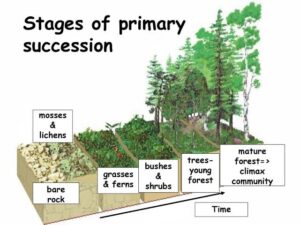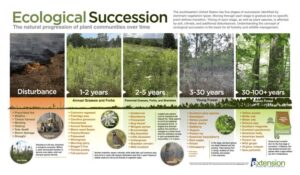Back to: Botany 300 Level
Hello, my amazing Afrilearn scholar! I hope you’re having a wonderful day! Have you ever wondered how different types of plants form communities in nature? Some plants prefer to live in forests, while others thrive in grasslands or wetlands. And just like people, these plant communities change over time. Today, we’re going to look at plant community classification and succession, which help us understand how plants live together and how they change over time. It’s going to be a fun journey, so let’s get started!
Plant community classification and succession
What is a Plant Community?
A plant community is simply a group of different plant species living together in the same area. They interact with each other and share resources like sunlight, water, and nutrients from the soil. Just like in human communities, plants in a community work together to survive, but they also face competition for resources.

Example in Nature:
In a forest, you might find tall trees, shrubs, grasses, and herbs all growing together, each contributing to the overall ecosystem.
Plant Community Classification
Plant communities can be classified based on the dominant vegetation (the most common or important plants in that area). These communities can vary depending on the environment, and there are two main types:
1. Terrestrial Plant Communities
These are plant communities found on land. They can be forests, grasslands, deserts, or wetlands.
Forests – In tropical rainforests, you’ll find tall trees like mahogany, while in temperate forests, you might find oaks or pines.
Grasslands – These communities are dominated by grasses and small plants, with few trees. They’re found in places like the savannah or the Nigerian grasslands.
Deserts – In deserts, you’ll find plants like cacti, which are adapted to survive with little water.
Wetlands – These are areas where water is constantly present, like swamps or mangroves, and the plants there are adapted to wet conditions.
2. Aquatic Plant Communities
These are plant communities found in water bodies like lakes, rivers, and oceans. They include floating plants, submerged plants, and plants along the edges of water bodies.
Example: Water lilies and papyrus plants in a swampy area.
Plant Succession: How Communities Change Over Time
Now that we know about plant communities, let’s talk about how they change over time. Succession is the process by which plant communities change and develop over time. It happens in two stages: primary succession and secondary succession.
1. Primary Succession
Primary succession happens in an area where no life exists before—like after a volcanic eruption or when a glacier melts. This is like starting with a blank slate. The first plants to colonise the area are usually pioneer species—plants that can survive in harsh conditions, like lichens or mosses.

Over time, these pioneer species break down rocks and help create soil. As the soil develops, other plants like grasses and small shrubs begin to grow, followed by bigger plants like trees. This process can take hundreds or even thousands of years!
Example: After a volcanic eruption, the first plants to grow are small, hardy plants like moss, followed by grasses, shrubs, and eventually a full forest.
2. Secondary Succession
Secondary succession happens in an area where there was once a plant community, but it was disturbed by a natural event like a fire, flood, or human activity like farming. Unlike primary succession, the soil is already in place, so this process happens much faster.
After a disturbance, small plants, grasses, and shrubs quickly grow back. Over time, larger plants like trees return, and the community eventually returns to what it was before the disturbance.
Example: After a forest fire, new plants like grasses and shrubs quickly grow back. Eventually, trees like pines or oaks return, and the forest recovers.
Summary
Plant communities are groups of plants that live together in the same area, and they can be classified into terrestrial (land) and aquatic (water) communities. Plant succession is the process by which these communities change over time. Primary succession starts from scratch, while secondary succession happens when a disturbed community recovers. Understanding these processes helps us learn how plants adapt to changing environments and how ecosystems recover after disturbances.
Evaluation
- What is a plant community, and how is it classified?
- What are the main stages of plant succession?
- How does primary succession differ from secondary succession?
- Can you think of an example of a plant community you’ve seen in nature?
You’re doing a fantastic job! Keep learning with Afrilearn, and you’ll be able to use this knowledge to protect our environment and understand how nature changes over time. Keep up the great work, and I’ll see you in the next lesson!
